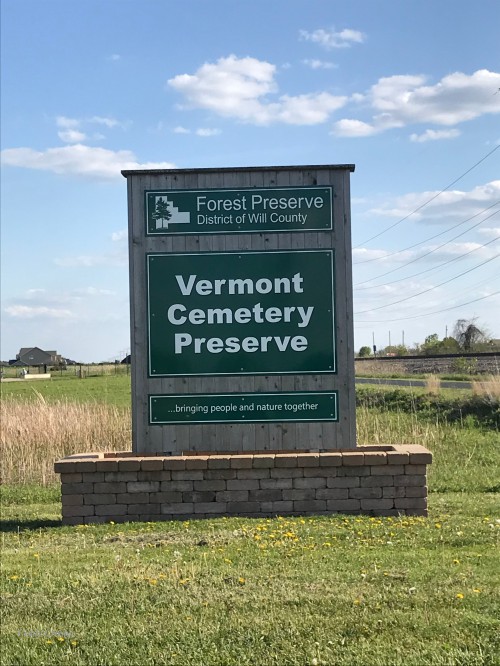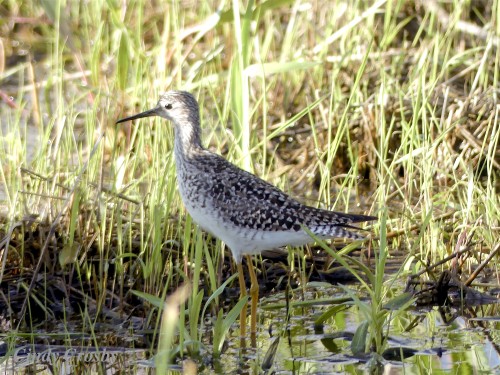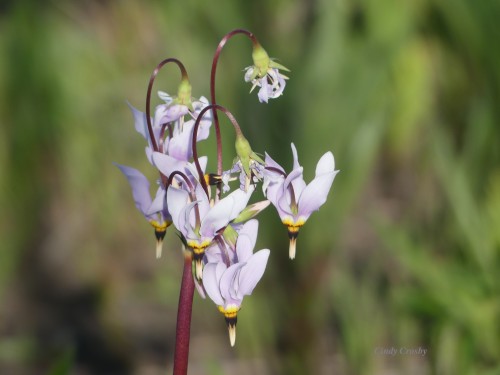“The prairie landscape insists on patience and commitment. It does not give up its secrets and wonders easily.” — James P. Ronda
*****
It’s the end of the work day at home, and I’m scrolling through Twitter. Then I see it —a tweet by tallgrass artist Liz Anna Kozik about a local prairie awash in shooting star blooms. A prairie I’ve never seen before! It’s only 30 minutes from my home. Jeff looks over my shoulder and sees the photo Liz has posted. Wow! We look at each other.
Let’s go!
The 37-acre Vermont Cemetery Prairie is part of the Forest Preserve District of Will County. One acre of the pioneer cemetery is designated as an Illinois Nature Preserve. This acre, untouched by agricultural plows which destroyed most of Illinois’ original 22 million acres of tallgrass prairie, is a rare piece of our history.

The cemetery is home to the federally endangered and state threatened Mead’s milkweed. Illinois has about two dozen native milkweeds, all of them host to the monarch butterfly caterpillar. I’ve seen many of these native milkweeds. But the Mead’s has been elusive. Maybe later this summer, I’ll see it here.

As we get out of the car, I’m disappointed. Prairie plants? Sure. The immediate area around the parking lot seems to be prairie wetland, and we spot some familiar species.

Birds are moving through. A killdeer. A mallard. Another mallard. And—what’s that?

Lesser yellowlegs? I think so. Tringa flavipes. For fun, I look up the meaning of its scientific name. I discover “Tringa” is “a genus of waders, containing the shanks and tattlers.” Hilarious! The Latin name flavipes is pretty straightforward: flavus is “yellow” and pes means “foot.” I love the scientific names; they always have a story to tell about a member of the natural world. I check the lesser yellowlegs’ range in Cornell’s All About Birds; it seems they are stopping here on their way to their breeding grounds up north.
We watch the lesser yellowlegs move through the wetlands for a while, then continue looking for the cemetery. Jeff spies it first—-the black fencing in the distance is a tip-off. The Tall Grass Greenway Trail runs parallel to the prairie, between the fence and railroad tracks, flanked by towering power lines.

A mammoth subdivision borders the other side of the preserve. House after house after house. But few people are at the prairie.

The fence, which keeps us out, is necessary, as the prairie would easily be damaged by vandalism or poaching. Remnants like this have almost vanished in Illinois; only about 2,300 high quality original prairie acres remain. Remaining prairie remnants tend to be along old railroad tracks, on rocky knobs unsuitable for farming (such as you find at Nachusa Grasslands in Franklin Grove, IL), or in cemeteries, such as these.
Jeff and I walk the perimeter. Outside the cemetery fence, even the ditch and buffer zones are a treasure trove of prairie plants. Golden Alexanders.

And its cousin, heart-leaved golden Alexanders.

Compass plants.

Wild strawberries.

Tall coreopsis.

Prairie dropseed.

All this on the outside of the fence! Magical. Could it really be any better inside?

We look in.

Wow.

So much shooting star. We see bumblebees among the graves, working the flowers in the early evening light.

Among the shooting star is wood betony…

..and so much hoary puccoon! These pops of orange are startling among the yellow of wood betony and the pink of shooting star. A few bastard toadflax throw white stars in the grasses. Sedges are in bloom too! But what species?
I have no idea.
The health of this prairie is a tribute to long-time dedicated stewards Don and Espie Nelson. (Watch a video about their work on this prairie here.) Without the efforts of this dynamic duo, this prairie would not be the vibrant, diverse place we see today. It also owes its existence to Dr. Robert Betz, a professor at Northeastern Illinois University, who worked to restore this remnant in the 1960s through cutting brush and using prescribed fire. He’s one of our Illinois prairie heroes.

I wonder what those who were buried here would have thought about the importance we put on the prairie flora found here today. Curious, I look up Wilhelmine Grabe, whose name appears on a gravestone with her husband, John Grabe. She was born in Germany, immigrated here, and died in 1895, at the same age as I am today. What did she think, when she came from the forests of Germany and first walked through a tallgrass prairie? Was she enchanted? Or was she afraid of the vast, empty spaces that became her new home? Did she and her husband, John, work hard to break the prairie sod so they could farm and grow food for their family? Would it puzzle her to see how much we value the last vestiges of prairie here?
I look up other names I see on the markers, but find nothing. There are many other gravestones worn beyond deciphering. All of these markers ask us to remember people who called the prairie state home for a portion of their lives. All of them are now at rest in one of the most beautiful cemeteries I’ve ever seen.

This prairie…these beautiful prairie wildflowers. This unexpected evening. This visit is a surprise that lifts my spirits and revives my sense of wonder.
The surprises have not all been good ones this week. My ginkgo tree, resilient and indestructible—-I thought — had leafed out. Then—wham! All of its leaves died this week.

Will it survive? I email the Morton Arboretum’s plant clinic, a free service the Morton Arboretum offers to anyone, anywhere. Sharon, a repository of expert plant knowledge, diagnoses freeze damage. She says it’s possible my little tree will summon enough energy to put out a new set of leaves.
Or not.
All I can do, she said, is watch…and wait.

I’ve gotten more practiced at watching and waiting the past two months. No problem.
Another surprise: Sunday evening, three and a half inches of rain fell in a few hours. The Arboretum is still closed because of the pandemic, so we drive to Leask Lane which borders the west side of the Schulenberg Prairie to see how the prairie has fared. There, we pull off the road to peer through the fence. Willoway Brook rampages wide and wild. As a steward, I know the seeds of invasive plants are coming in with this deluge, and will require attention as the waters subside.

It’s a challenge I anticipate. But it will be a few more weeks before the Morton Arboretum is open. Although my steward work won’t resume for a bit longer, I’ll be able to hike the Schulenberg Prairie again in less than two weeks. At last. At last.
I’m anxious to see what the past two months have brought to the prairie. I look over the fence and wonder. Are the small white lady’s slipper orchids in bloom? This should be their week. I remember the delight of discovering them nestled deep in the new grasses.

It’s a discovery that has never lost its charm, year after year.
What about the shooting star? Will they be visible, even with the old growth, unburned, still in place? Try as I might, I can’t see them. But I remember them, from previous years.

I think of these years, and how beautiful the wildflowers were. I imagine the queen bumblebees, alighting on one bloom after another, using their strong thoracic muscles—-performing “buzz pollination”—to loosen the pollen. Like salt sprinkled from a salt shaker. One thought led to another. Had the federally endangered rusty patched bumblebee emerged? Was it out and about in the wildflowers?

I wonder if the first eastern forktail damselflies are emerging along Willoway Brook, and what effects the water’s rise and fall are having on the dragonfly and damselfly populations.

So much is happening! So much to anticipate. June 1, I’ll be back on the prairie I’ve grown to love for the past 22 years where I’ve been steward for almost a decade. Less than two weeks to go now. Until then, I peer through the fence.
It will be worth the wait.
****
James P. Ronda, whose quote kicks off the blog today, is the author of Visions of the Tallgrass from University of Oklahoma Press. If you haven’t seen this book of lovely essays with gorgeous photographs by Harvey Payne, check it out here.
****
All photographs taken at Vermont Cemetery Prairie, Forest Preserve District of Will County, Naperville, IL unless otherwise noted; copyright Cindy Crosby (top to bottom): sign; view of the wetlands; lesser yellowlegs (Tringa flavipes); approach to cemetery remnant; approach to cemetery remnant; golden Alexanders (Zizia aurea); heart-leaved golden Alexanders (Zizia aptera); compass plant (Silphium laciniatum); wild strawberries (Fragaria virginiana); tall coreopsis (Coreopsis tripteris); prairie dropseed (Sporobolus heterolepis); cemetery fence; shooting star and gravestone (Dodecatheon meadia); shooting star (Dodecatheon meadia); shooting star (Dodecatheon meadia) and gravestone; wood betony (Pedicularis canadensis), hoary puccoon (Lithospermum canescens) and bastard toadflax (Comandra umbellata); prairie and power lines; ginkgo tree (Ginkgo biloba), author’s front yard, Glen Ellyn, IL; compass plant (Silphium laciniatum); Willoway Brook, Schulenberg Prairie, The Morton Arboretum, Lisle, IL; small white lady’s slipper orchid (Cypripedium candidum), Schulenberg Prairie, The Morton Arboretum, Lisle, IL–photo from previous years; shooting star (Dodecatheon meadia), Schulenberg Prairie, The Morton Arboretum, Lisle, IL–photo from previous years; shooting star (Dodecatheon meadia); eastern forktail (Ishnura verticalis), Schulenberg Prairie, The Morton Arboretum, Lisle, IL.
Tremendous thanks to Liz Anna Kozik for the heads up about Vermont Cemetery Prairie. Check out her tallgrass prairie graphic comics and other art here.
***
Join Cindy for a class online!
“Tallgrass Prairie Ecology” class online in May through The Morton Arboretum is SOLD OUT. Sign up now to ensure a spot in our June 7 class here.
Nature Journaling is online Monday, June 1 — 11am-12:30pm through The Morton Arboretum:
Explore how writing can lead you to gratitude and reflection and deepen connections to yourself and the natural world. In this workshop, you will discover the benefits of writing in a daily journal, get tips for developing the habit of writing, and try out simple prompts to get you on your way. (WELL095) — Register here.

Thank you for recognizing the excellent work of Dr. Betz and Don and Espie Nelson. They are humble about their decades of dedicated volunteer work but they have made an immense impact on the richness of our natural areas. They are living legends.
I had a chance to seed collect with a small FPDWC crew and will never forget the amazing diversity of species filling areas between weathered ’grave markers. I joked that these folks were lucky to have such a pretty place to rest.
LikeLiked by 1 person
It boggles the mind to think of the changes Dr. Betz made to our prairie heritage, doesn’t it? Wow. Don and Espie are such unassuming, delightful people. I worked with them for years on the Schulenberg Prairie (evening crew) without ever knowing of their work at Vermont Cemetery Prairie. They are amazing! Lucky you, to seed collect there!!! How amazing…. thanks for reading, for sharing, and for dropping me a note. Grateful! –Cindy 🙂
LikeLike
What a hidden treasure! And Don and Espie Nelson need a younger generation to bequeath this prairie to. How to find that next generation for this location? They have taken such loving care of this sacred place. I wish the descendants of these prairie settlers could know.
LikeLiked by 1 person
Hello, Paula — Thank you for reading and for dropping me a note. They are going to leave big shoes to fill, for sure. I’m grateful for these amazing stewards, and the prairies they care for that continue to delight us! — Cindy 🙂
LikeLike
What a discovery in Vermont. Beautiful prairie in the cemetery. Thanks for sharing this gem.Also, thanks for the info on the gingko trees. I’ve been worrying about mine and noticed all of the gingko trees in the neighborhood having the same problem. Hoping they all survive and that the leaves reemerge soon. Changing climate is causing all sorts of trouble.Hope you are well. Looking forward to June 1, too!!Teri
LikeLiked by 1 person
Hello, Teri — I was just thinking about our prairie group this morning — it would have been a very wet workday! Interesting that you’ve noticed the same thing on local ginkgos…. so sad to see this happen. Hope you are well, and enjoying some time in the garden! Thanks for reading, and dropping me a note. –Cindy 🙂
LikeLike
ok, not native but……I spy peonies also at gravesites. I love the old heritage peony found in cemeteries.
LikeLiked by 1 person
So interesting, isn’t it? The hour we spent there prompted all sorts of questions about what you leave (restoration wise) that’s a part of history and what you remove (lily of the valley, maybe?). A little window into the past. I would love to have a good long talk with Don and Espie… they are such amazing stewards. Thanks for reading, Mike! And for taking time to write me a note. Happy spring!–Cindy 🙂
LikeLike
That’s really interesting to read about the Vermont Cemetery Preserve, had no idea it even existed even though I am not that far away.
I noticed my gingko isn’t doing well either and was sad and surprised as they are supposed to be almost indestructible. Now, thanks to your blog, I know why. I also noticed that my London Plane Tree, planted about 3 years ago, looks very much dead this year, probably for the same reason.
LikeLiked by 1 person
Hello, Lai —
I’m sorry to hear about your ginkgo! I also thought they were indestructible. Today, I noticed a little bit of green leaf on one of the branches. My fingers are crossed it will put out some new leaves, and survive this! I hope you have a chance to visit Vermont Cemetery Prairie. Such an amazing place! Thank you for reading the blog, and taking time to drop me a note. — Cindy 🙂
LikeLike
Your post left me filled me with sadness you cannot know the status of your prairie. To be there for your beloved prairie plants and insects. You have an amazing ability to take us on your nature journeys. We all need to get out and into nature more often!
LikeLiked by 1 person
Thank you Nancy, for reading and leaving me a kind note!! So grateful! ☺️ I hope you are finding opportunities to get outside. I agree—nature is such solace! —Cindy
LikeLike
This is just lovely!♥️
On Tue, May 19, 2020 at 7:18 AM Tuesdays in the Tallgrass wrote:
> Cindy Crosby posted: “”The prairie landscape insists on patience and > commitment. It does not give up its secrets and wonders easily.” — James > P. Ronda ***** It’s the end of the work day at home, and I’m scrolling > through Twitter. Then I see it —a tweet by tallgrass artist ” >
LikeLiked by 1 person
Thank you for taking time to read and drop me a note! Grateful. — Cindy 🙂
LikeLike